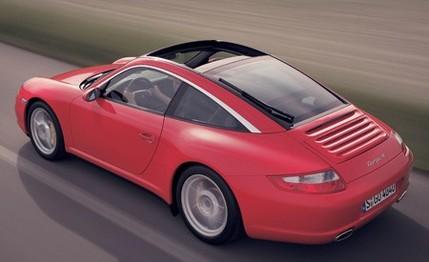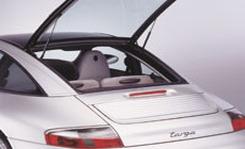
 First Drive Review
First Drive Review
Our first taste of Porsche's new convertible/coupe combination took place in circumstances that wannabe Porsche owners dream about and commercial movie directors depict in extravagant productions.
It was a long, fast drive in the Tirolean Alps in western Austria, with the sun bright in the sky and a nice cool edge to the breeze. Too late in the season for heavy tourist traffic, the roads were mostly deserted.
That left us free to buzz through the mountains in a fleet of new 911 Targas, thrilling to the sound of the engine pouring in through the large hole in the roof that distinguishes the Targa from other 911s.
"The Targa is neither a coupe nor a convertible." That's how Ferry Porsche, son of the founder of this sports-car company, characterized the first Targa back in 1965, when the concept vehicle debuted in Frankfurt. Since then the 911 Targa has evolved into a coupe with a gigantic glass sunroof. This latest example boasts all the upgrades enjoyed by the 911 line for 2002. To wit: a 3.6-liter engine (up from 3.4) with a new VarioCam Plus valve-timing system that helps lift output to 315 horsepower and 273 pound-feet of torque.
In front, the Targa shows the same new face found on all 2002s, and it's only aft of the windshield that important differences are seen. A rigid tubular structure bridges the A- and C-pillars and replaces the standard sheet-steel roof. A modular sliding-roof unit with a 16.6-square-foot glass panel is manufactured by roof specialist CTS and delivered to Zuffenhausen just in time to meet Targas coming down the line.
There the module is fitted by robot to the modified 911 body shells, inserted from the bottom to protect the rubber seals for long-term weatherproofing. Powered by two electric motors, the roof deploys in about eight seconds, providing an open area twice as big as that of a standard sunroof. The glass panel slides back under the rear window, where it forms a double layer of glass and--unfortunately--results in some obstruction of rearward visibility.


But, hey, you can't make an omelet without breaking eggs, and the Targa roof is the easiest way of having a near-cabrio experience while retaining full coupe convenience and security. Porsche spokesmen report that the Targa has structural stiffness "about the same as the coupe in bending rigidity and somewhere between the coupe and convertible in torsion."
Which means it isn't as stiff as the coupe or as shivery as the convertible. On Austria's mostly fine Alpine roads, this translated to a solid-feeling car, with all the athletic prowess of the 911 coupe but with far better sound effects.
Because the roof is glass--tinted and laminated safety glass--Porsche has provided a power sunshade that runs in a track independently of the roof panel, so it can be placed almost anywhere overhead as needed to shade the occupants.
All of which would be to no avail were it not for the careful aerodynamic work that attended this car's development. A wind deflector integrated into the roof module fends off nasty drafts and buffeting, allowing the driver to run at high speed with minimal turbulence inside the car when the roof is open. Sure, the noise level is a little higher, but the Targa is otherwise extremely comfortable.
The Targa model is a bit more versatile than the coupe, in that it features an opening rear window something like the setup in the Corvette targa. Gas-pressurized struts help open and support the hinged glass panel, and an electric lock pulls it shut through the last few degrees.
With the 911's vestigial rear seatbacks folded forward, this provides pretty good space for packages and groceries. It's just a pity there's a pronounced ridge on the rear shelf, or it would be even more usable.
But why, you ask, do just 10 percent of 911 buyers go for the Targa? The answer is that the special assembly process keeps the production numbers down while bumping the price up. How far up? We're not sure yet, but a look at European prices suggests a $6000 premium for a Targa.
There's also the little matter of the 150 pounds the roof module adds to the weight of a Carrera coupe, and the fact that the coupe does come with a sunroof, although it's a mail slot compared with the yawning expanse of the Targa's vista.
So, the Porsche Targa will most likely appeal to the same 10 percent of 911 shoppers who like the idea of a bright and airy driving experience along with the measure of exclusivity a rare model imparts.
Nice to have the choice, isn't it?